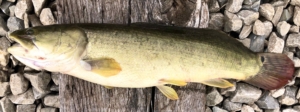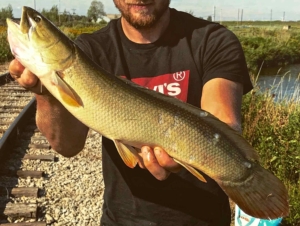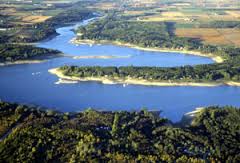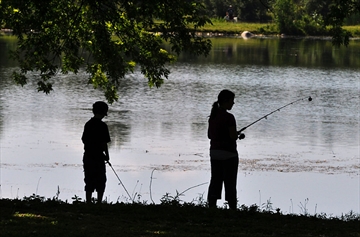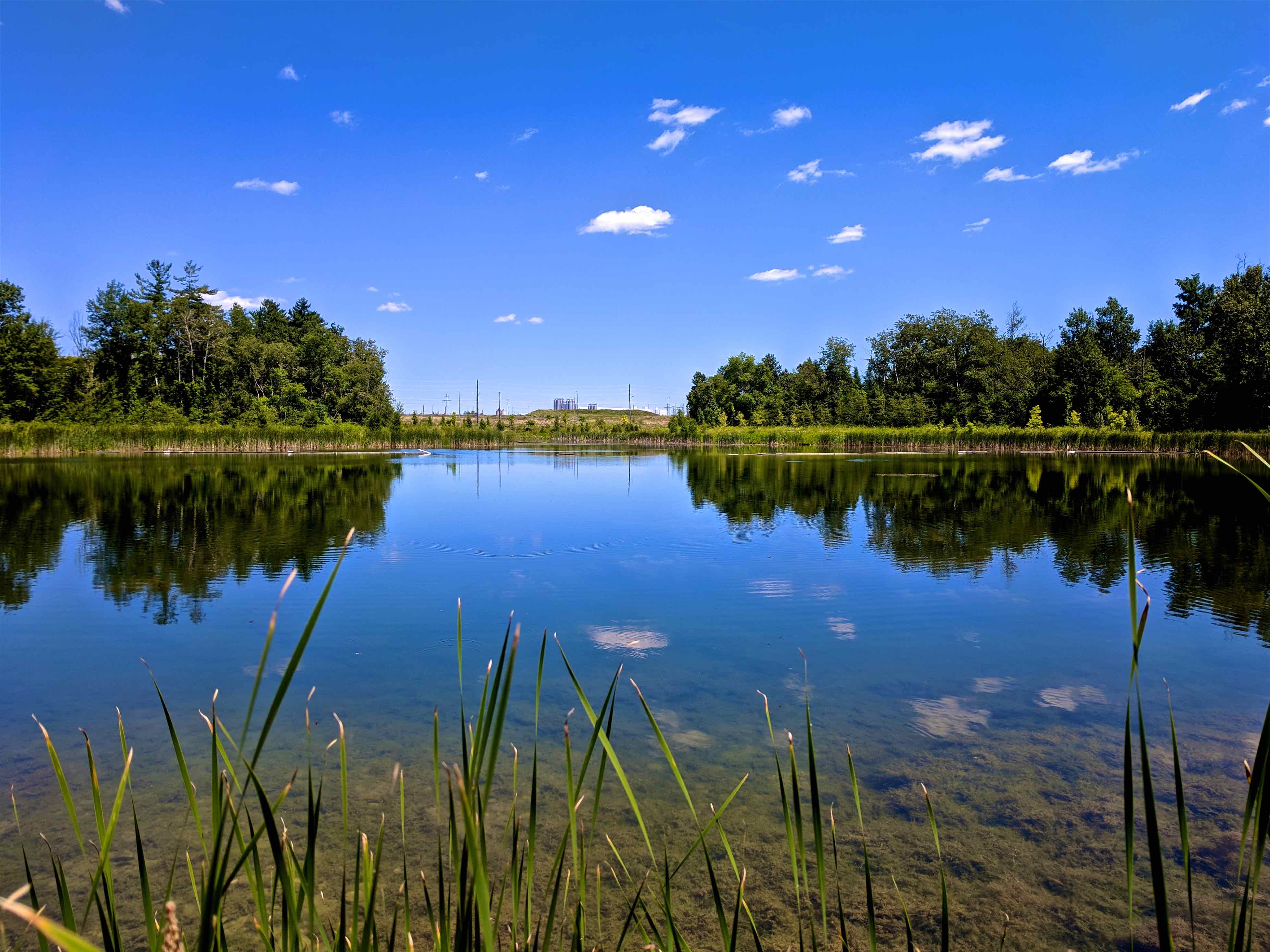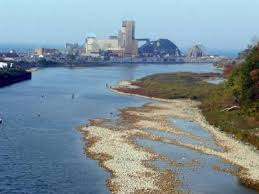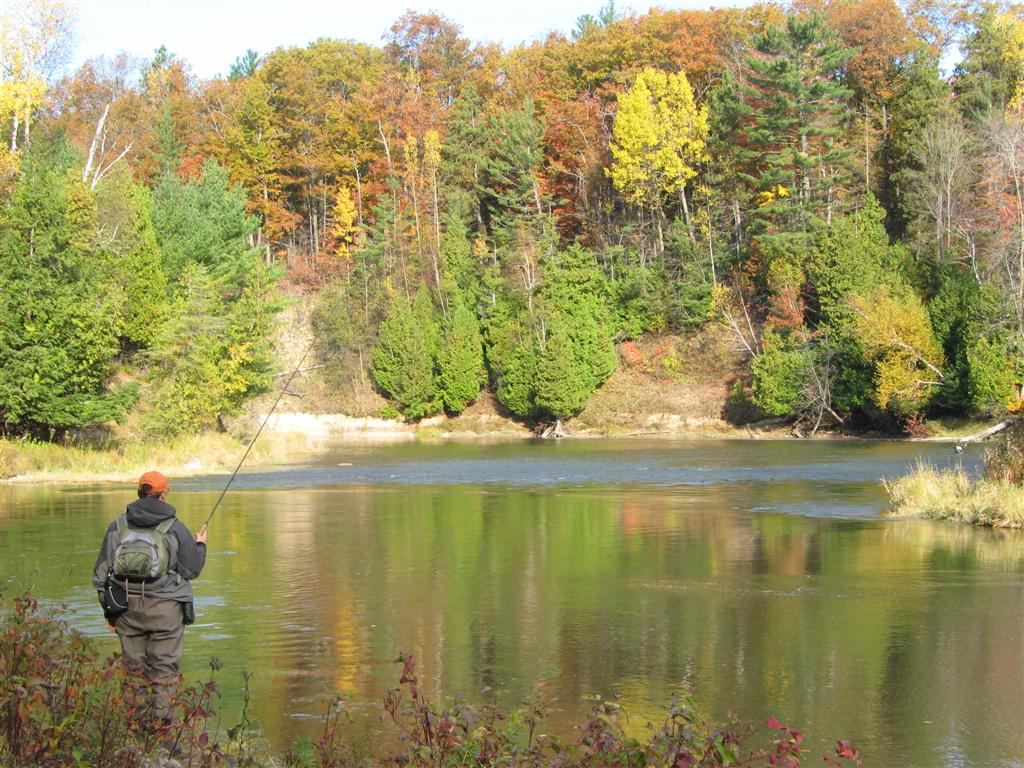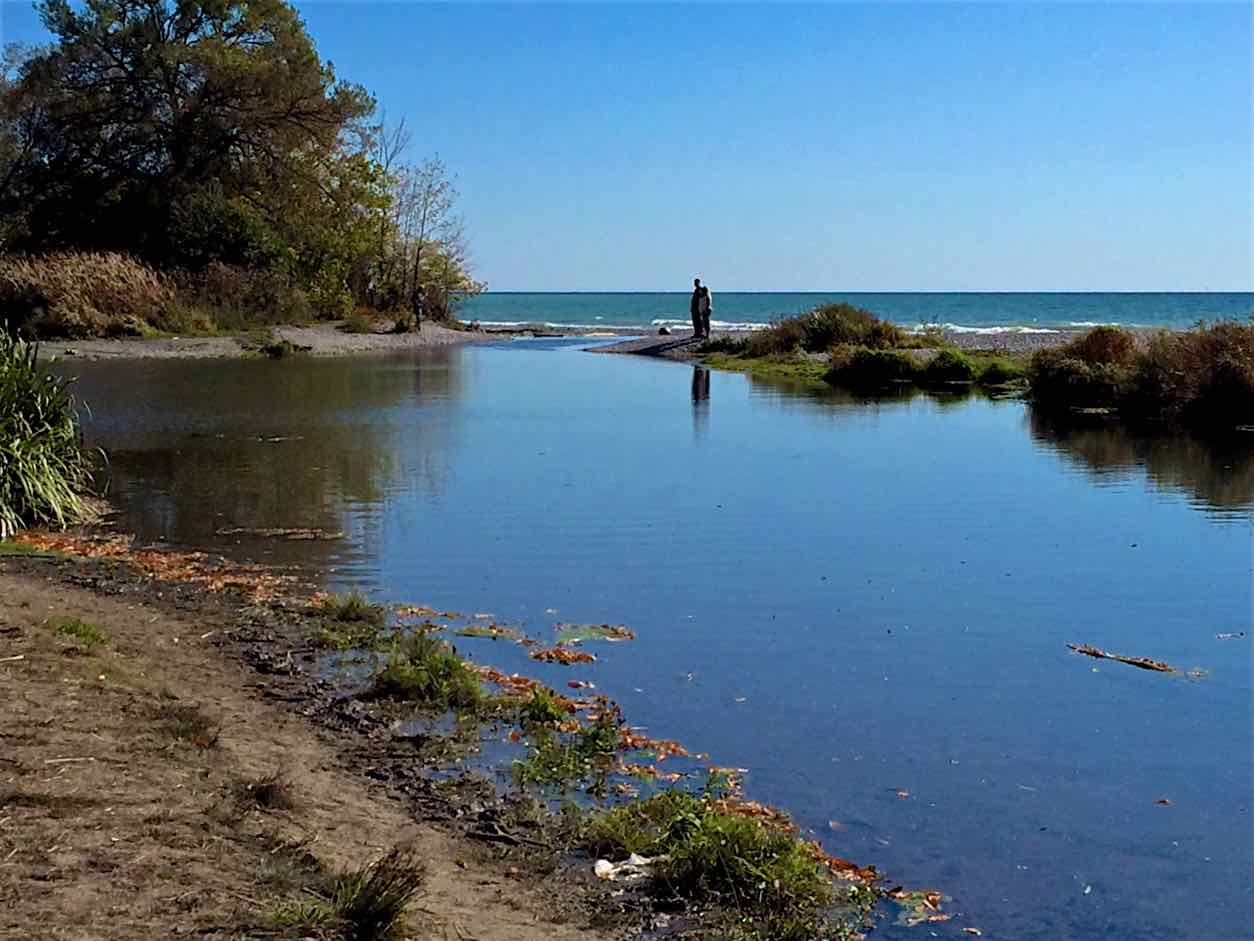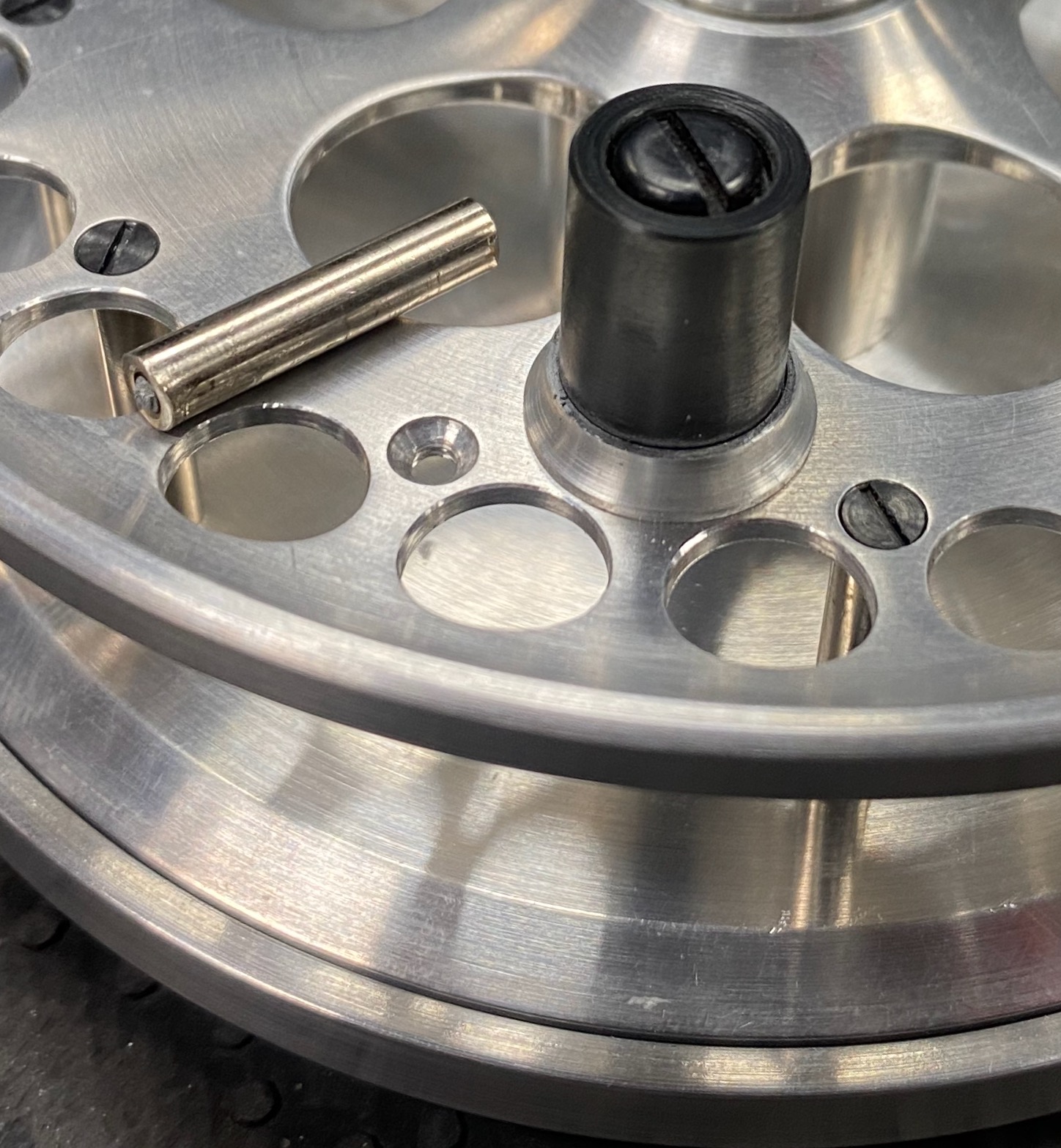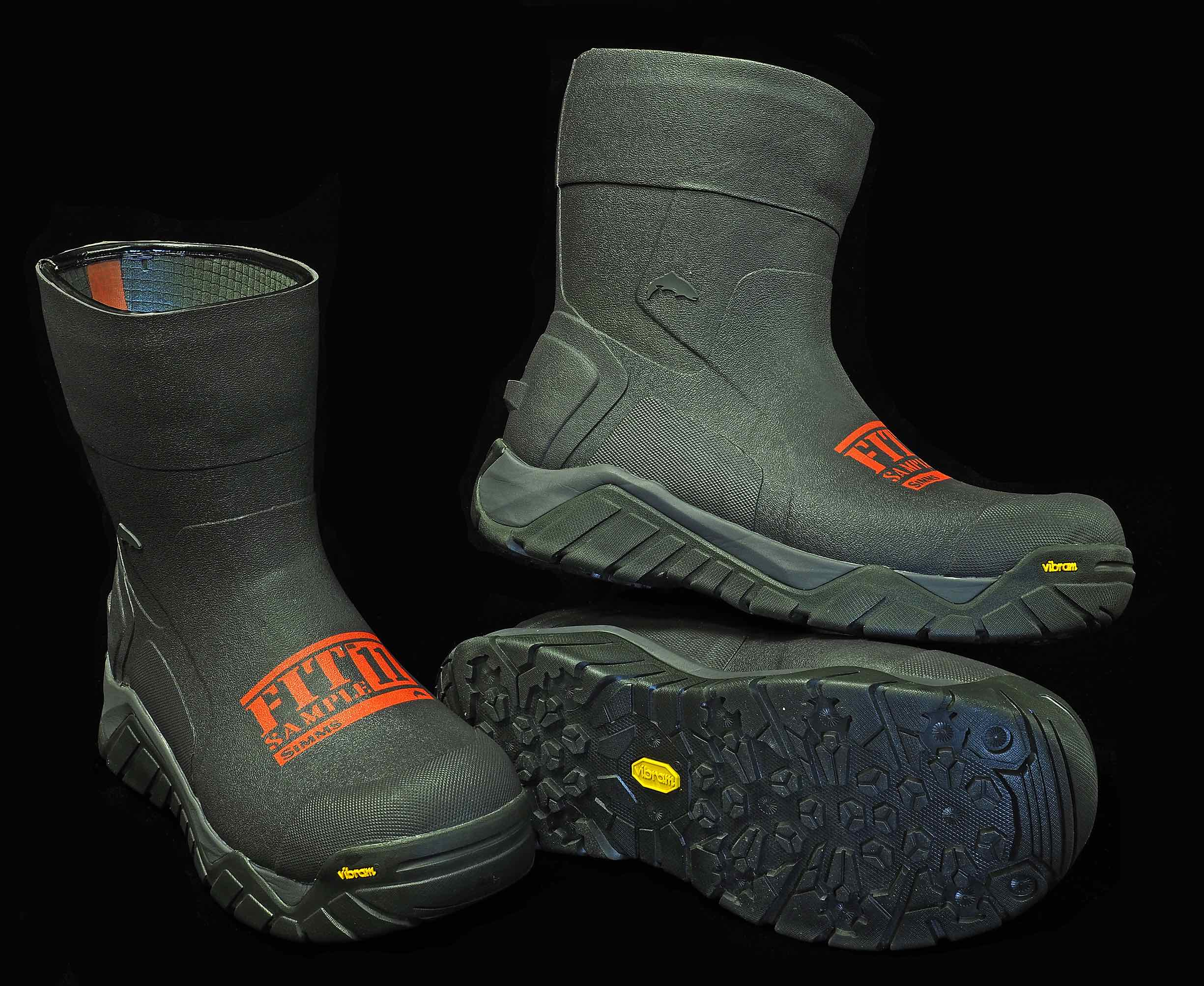The Bowfin – A Disrespected Living Fossil …
Article by Randy Jackson, Senior Research Associate, Cornell University
One of New York’s most unique fish, the bowfin is the sole living survivor of a group of fishes whose fossil representatives date back to when dinosaurs roamed the earth.
The features of today’s bowfin differ very little from their fossil ancestors dating back 65 million years, so they offer a true glimpse into New York’s prehistoric past.
Range:
Bowfin are widespread through the eastern United States.
Their native range extends from the St. Lawrence and Ottawa Rivers and Lake Champlain west through the Great lakes and south down the Mississippi to the Gulf of Mexico, west to the Texas border, east through the state of Florida and up the Atlantic coast.
In New York, they can be found in the Great Lakes, St. Lawrence River and Lake Champlain drainages and have been introduced into a few waters in the southeastern part of the state.
Biology:
The bowfin’s appearance is as distinctive as its character.
Their body is roughly torpedo shaped, with a bullet-shaped head.
Their mouth contains rows of short, sharp teeth on both the upper and lower jaws.
The fin along their back runs more than half the total length of the fish, and the tail fin is larger towards the top than the bottom.
Bowfin are greenish in color, sometimes with brown or gray shading, and have a white or yellow underside.
The fins and underside of males often take on a bright lime green color during the spawning season.
Male bowfin also have a distinctive dark spot near the tail fin that is oftentimes ringed with orange or yellow.
Bowfin spawn in New York in May or June. Like bass, male bowfin build nests and attract spawning females who deposit eggs and leave the spawning grounds.
Males guard the eggs and young until they reach sizes of 3 inches or more.
The bowfin has a fleshy swim bladder that functions much like our lungs, allowing them to obtain oxygen by gulping air. Although bowfin are often found in the same heavily vegetated areas preferred by largemouth bass, they are particularly well-suited to swampy habitats with low oxygen.
The bowfin is a voracious predator, with a fondness for crayfish, but will readily feed on any available fish.
Image Problem!
Wherever they are found, bowfin suffer from a bad public image.
They are known regionally by a variety of common names- dogfish, mudfish, grindle, ling, and lawyer-all suggestive of their status as a fish people love to hate.
Both anglers and the earliest generations of fish biologists thought that the bowfin’s predatory nature made it a threat to more desirable sport fish.
Efforts were undertaken in many waters to reduce bowfin numbers.
Important Part of Our Fish Communities:
We know now that bowfin are an important part of the balance of our fish communities, helping control the numbers of prey fish capable of overpopulating our waters, and rarely consuming other sport fish or acting as a serious competitor with them for food.
A Prized Gamefish?
While their aggressive nature does not threaten populations of more popular fish, it does instill them with many of the traits anglers prize in a fish.
They frequently attack lures aggressively and can put up a tremendous fight, particularly when fishing with lighter tackle.
Bowfin can be caught while fishing the same habitats, and with the same techniques and lures used for largemouth bass, and seem particularly fond of the color purple.
Their fighting instincts can make landing them a struggle, and their sharp teeth also make them well-equipped for breaking fishing lines.
Bowfin reach sizes that would challenge any angler. The current state record is a 12-pound, 14-ounce fish caught from Lake Champlain.
The world record is a 21-pound 8-ounce fish caught in South Carolina. Their flesh is soft, and not considered edible by most, so this is a fish best suited for the catch-and-release angler.
Bowfin Research:
Because they are not generally valued as a sport or food fish, few detailed studies of bowfin have been conducted by fish biologists.
One recent exception is a study by Cornell University biologists on Oneida Lake.
They implanted radio transmitters in 40 bowfin and tracked them from 2009-2011.
Prior to the study, most biologists assumed bowfin were lethargic fish, staying close to preferred habitats and moving little.
Many of the Oneida bowfin proved much more energetic-sometimes moving eight miles or more between weekly locations.
Bowfin occupied unique spawning and growing season habitats, but individual fish returned annually to the same areas they were found in the year before, exhibiting a fidelity to home areas.
This study adds a little light to the character of the bowfin, and combined with their unique place in New York’s fish fauna, will hopefully help people appreciate them and their place in our waters.
The body of the bowfin is elongated and cylindrical, with the sides and back olive to brown in color, often with vertical bars, and dark reticulations, or camouflaged pattern. The dorsal fin has horizontal bars, and the caudal fin has irregular vertical bars. The underside is white or cream, and the paired fins and anal fin are bright green. During larval stage, hatchlings from about 7–10 mm (0.28–0.39 in) total length are black and tadpole-like in appearance. At approximately 25 mm (0.98 in) total length they have been described as looking like miniature placoderms. They grow quickly, and typically leave the nest within 4 to 6 weeks after hatching. Young males have a black eyespot on the base of the tail (caudal peduncle) that is commonly encircled by an orange-yellowish border while the female’s is black, if present at all. It is thought the purpose of the eyespot is to confuse predators, deflecting attacks away from the head of the fish to its tail, which affords the bowfin an opportunity to escape predation. The bowfin is so named for its long, undulating dorsal fin consisting of 145 to 250 rays, and running from the middle of the back to the base of the tail.
The first fish lacked jaws and used negative pressure to suck their food in through their mouths. The jaw in the bowfin is a result of their evolutionary need to be able to catch and eat bigger and more nutritious prey. As a result of being able to gather more nutrients, Bowfin are able to live a more active lifestyle. The jaw of a bowfin has several contributions. The maxilla and premaxilla are fused and the posterior chondrocranium articulates with the vertebra which allows the jaw freedom to rotate. The suspensorium includes several bones and articulates with the snout, brain case, and the mandible. When the jaw opens epaxial muscles lift the chondrocranium which is attached to the upper jaw, and adductor muscles close the lower jaw. This ability to open and close the jaw allows the bowfin to become more of a predator, in that it can catch bigger prey and be able to mechanical catch, and digest it.
Bowfin, like other physostomes such as bichirs (Polypteridae), gars (Lepisosteidae), and the lungfish (Dipnoi), are capable of bimodal respiration. They can extract oxygen from the water when breathing through their gills, and can also break the water’s surface to breathe or gulp air through a small pneumatic duct connected from their foregut to the gas bladder. When performing low-level physical activity, bowfin obtain more than half of their oxygen from breathing air. Bowfin have two distinct air-breathing mechanisms used to ventilate the gas bladder. Type I air breaths are consistent with the action of exhale-inhale stimulated by aerial or aquatic hypoxia to regulate O2 gas exchange; type II air breaths are by inhalation alone which is believed to regulate gas bladder volume for buoyancy control. Bimodal respiration helps bowfin survive and maintain their metabolic rate in hypoxic conditions. The rate of air breathing is higher in darkness, when the fish is more active.
Bowfin are stalking, ambush predators that customarily move into the shallows at night to prey on fish, and aquatic invertebrates such as crawfish, mollusks, and aquatic insects. Young bowfin feed mostly on small crustaceans, while adults are mostly piscivorous, but also known to be opportunistic. Bowfin are remarkably agile, can move quickly through the water, and they have a voracious appetite. Their undulating dorsal fin propels them silently through the water while stalking their prey. The attack is straightforward and swift with a movement that lasts approximately 0.075 seconds. There were also some studies regarding the capacity of the bowfin to survive without food. In 1916, A female bowfin was starved for twenty months. It was the longest period that any vertebrate had been without food, as far the writer was aware during the observation. Some independent studies focus on the bowfin’s ability to use organic material as a source of food and studied the structure of the gill raker. They concluded that it did not benefit from the organic material in the water because the gill rakers were short with blunt processes and a short space between them. Even bacteria could enter and exit through the gill easily. Its structure alone indicated that the Amia don’t use microorganisms as a source of food.
Bowfin spawn in the spring or early summer, typically between April and June, more commonly at night in abundantly vegetated, clear shallow water in weed beds over sand bars, and also under stumps, logs, and bushes. Optimum temperatures for nesting and spawning range between 16–19 °C (61–66 °F). The males construct circular nests in fibrous root mats, clearing away leaves and stems. Depending on the density of surrounding vegetation there may be a tunnel-like entrance at one side. The diameter of the nests commonly range between 39–91 cm (15–36 in), at a water depth of 61–92 cm (24–36 in).
During spawning season, the fins and underside of male bowfin often change in colour to a bright lime green. The courtship/spawning sequence lasts one to three hours, and can repeat up to five times. Courtship begins when a female approaches the nest. The ritual consists of intermittent nose bites, nudges, and chasing behavior by the male until the female becomes receptive, at which time the pair lie side by side in the nest. She deposits her eggs while he shakes his fins in a vibratory movement, and releases his milt for fertilization to occur. A male often has eggs from more than one female in his nest, and a single female often spawns in several nests.
Females vacate the nest after spawning, leaving the male behind to protect the eggs during the eight to ten days of incubation. A nest may contain 2,000 to 5,000 eggs, possibly more. Fecundity is usually related to size of the fish, so it isn’t unusual for the roe of a large gravid female to contain over 55,000 eggs. Bowfin eggs are adhesive, and will attach to aquatic vegetation, roots, gravel, and sand. After hatching, larval bowfin do not swim actively in search of food. During the seven to nine days required for yolk-sac absorption, they attach to vegetation by means of an adhesive organ on their snout, and remain protected by the parent male bowfin. Bowfin aggressively protect their spawn from the first day of incubation to a month or so after the eggs have hatched. When the fry are able to swim and forage on their own, they will form a school and leave the nest accompanied by the parent male bowfin who slowly circles them to prevent separation.
Bowfin reach sexually maturity at two to three years of age. They can live ten to twelve years in the wild, and 30 years in captivity. Females are longer-lived than males.
We are the leading provider of Fly Fishing Lessons, Corporate Team Building, and Guiding on the Upper Grand River, the Upper Credit River, and the Conestogo River.
No Guelph, Fergus, Kitchener or Cambridge Fishing Tackle Retailer will boast as complete and diverse a store inventory, including a vast selection of Centerpin / Float Fishing Reels, Rods, Clothing and Accessories.
Order a HLS or TFC Gift Card – We will put one in the mail for FREE!
Fly Shop Flyshop Flyfish Grand River Fly fish Grand River Guide Grand River Lesson Grand River Fergus Ontario Canada


